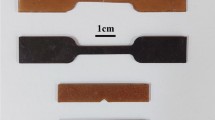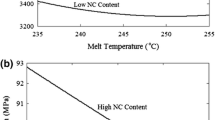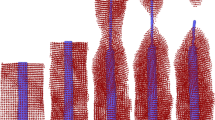By the surface response method, a regression equation is constructed, and the tensile elastic modulus of films made from polyvinyl alcohol/polyvinyl acetate (PVA/PVAc) blends filled with montmorillonite clay and microcrystalline cellulose nanoparticles is investigated. It is established that the introduction of the nanoparticles improves the mechanical properties of the blends in tension considerably: their strength and elastic modulus increase with content of the particles. Using the regression equation, the optimum composition of nanoparticlefilled PVA/PVAc blends with the highest value of elastic modulus is found.


Similar content being viewed by others
References
S. N. Ushakov, Polyvinyl Alcohol and Its Derivatives [in Russian], Izdat. Akad. Nauk, Moscow–Leningrad, 2, 781-790 (1960).
M. E. Rosenberg, Polymers on the Basis of Vinylacetate [in Russian], Khimiya, Leningrad, 103-115 (1983).
N. A. Peppas and D. Tennenhouse, “Semicrystalline poly(vinyl alcohol) films and their blends with poly(acrylic acid) and poly(ethylene glycol) for drug delivery applications,” J. Drug Del. Sci. Tech., 14, No. 4, 291-297 (2004).
C. Vasile and A. K. Kulshreshtha, Handbook of Polymer Blends and Composites. Vol. 4, Rapra Technology (2003).
S. Patachia, C. Vasile, and E. Mavru, “Study of the compatibility in the poly(vinyl-chloride)/poly(vinyl-alcohol) system,” Polym. Bull., 13, No. 4, April, 301-306 (1985).
Y. Chun-Chen, J. M. Yang, and W. Cheng-Yeou, “Poly(vinyl alcohol)/poly(vinyl chloride) composite polymer membranes for secondary zinc electrodes,” J. Power Sources, 191, No. 2, 669-677 (2009).
N. Jelinska, M. Kalnins, V. Tupureina, and A. Dzene, “Poly(vinyl alcohol)/poly(vinyl acetate) blend films,” Sci. J. Riga Techn. Univ., Mater. Sci. Appl. Chem.,21, No. 2, 55-61 (2010).
N. Jelinska and M. Kalnins, “Strength and deformation characteristics of polymer blend films obtained from water systems,” Mech. Compos. Mater., 47, No. 5, 581-588 (2011).
S. Pavlidou and C. D. Papaspyrides, “A review on polymer-layered silicate nanocomposites,” Progress Polymer Sci., 33, No. 12, 1119-1198 (2008).
M. Laka and S. Chernyavskaya, “Obtaining and properties of microcrystalline cellulose from hardwood pulp,” Sci. J. Riga Techn. Univer., Mater. Sci. Appl. Chem., 14, No. 2, 7-14 (2007).
S. Sinha Ray and M. Okamoto, “Polymer/layered silicate nanocomposites: a review from preparation to processing,” Progr. Polym. Sci., 28, No. 11, 1539-1641 (2003).
J. Ma, J. Xu, J. Ren, Z. Yu, and Y. Mai, “A new approach to polymer/montmorillonite nanocomposites,” Polymer, 44, No. 16, 4619-4624 (2003).
M. Biswas and S. S. Ray, “Recent progress in synthesis and evaluation of polymer-montmorillonite nanocomposites,” Adv. Polym. Sci., 155, 167-221 (2001).
J. Jordan, K. I. Jacob, R. Tannenbaum, M. A. Sharaf, and I. Jasiuk, “Experimental trends in polymer nanocomposites — a review,” Mater. Sci. Eng.: A: Review, 393, Nos. 1/2, 1-11 (2005).
S. C. Tjong, “Structural and mechanical properties of polymer nanocomposites,” Mater. Sci. Eng.: R: Reports, 53, Nos. 3/4, 73-197 (2006).
D. C. Montgomery, Solutions. Design and Analysis of Experiments, Wiley, New York (2012).
F. L. Hong, J. Peng, and W. B. Lui, “Optimization of the process variables for the synthesis of starch based biodegradable resin using response surface methodology,” J. Appl. Polym. Sci., 119, No. 3, 1797-1804 (2011).
V. Sridhar, K. Prasad, S. Choe, and P. P. Kundu, “Optimization of physical and mechanical properties of rubber compounds by a response surface methodological approach,” J. Appl. Polym. Sci., 82, No. 4, 997-1005 (2001).
R. Rikards and A. Chate, “Optimal design of sandwich and laminated composite plates based on the planning of experiments,” Struct. Optimization, 10, No. 1, 46-53 (1995).
R. Rikards, A. K. Bledzki, V. Eglajs, A. Cate, and K. Kurek, “Elaboration of optimal design models for composite materials from data of experiments,” Mech. Compos. Mater., 28, No. 4, 435-445 (1992).
V. Eglajs, “Approximation of data by the multi-dimensional regression equationion,” Probl. Dynam. Strength, 39, 120-125 (1981).
Acknowledgments
This study was financially supported by the Latvian Ministry of Education and Science, Contract No. V7909.1.
Author information
Authors and Affiliations
Corresponding author
Additional information
Translated from Mekhanika Kompozitnykh Materialov, Vol. 51, No. 5, pp. 945-954 , September-October, 2015.
Rights and permissions
About this article
Cite this article
Jelinska, N., Kalnins, M., Kovalovs, A. et al. Design of the Elastic Modulus of Nanoparticles-Containing PVA/PVAc Films by the Response Surface Method. Mech Compos Mater 51, 669–676 (2015). https://doi.org/10.1007/s11029-015-9537-0
Received:
Published:
Issue Date:
DOI: https://doi.org/10.1007/s11029-015-9537-0




